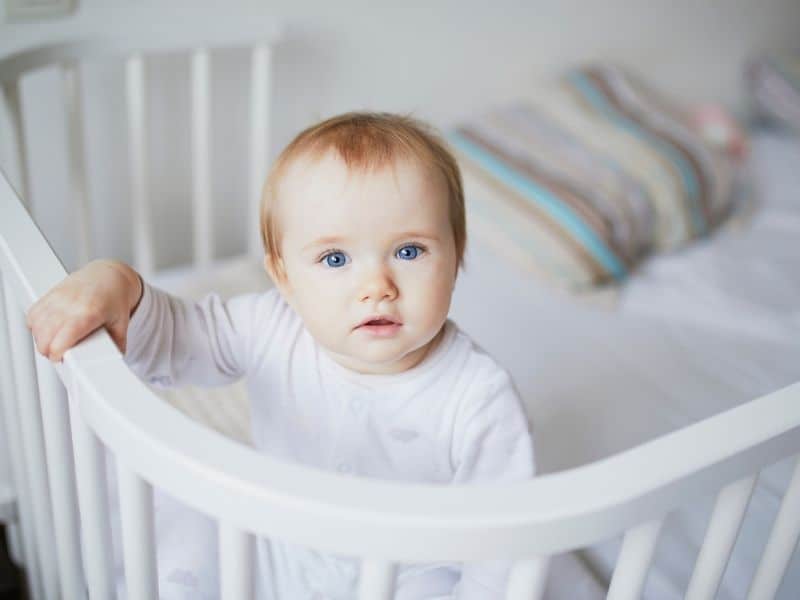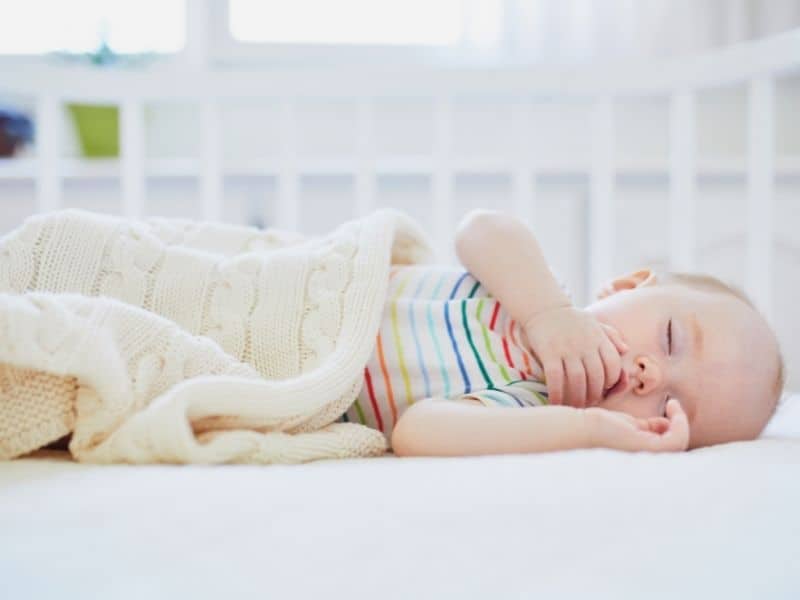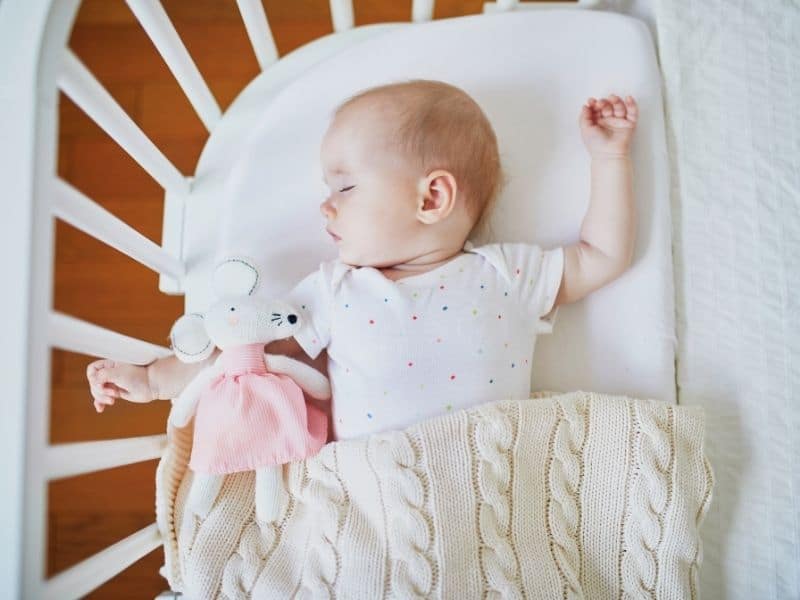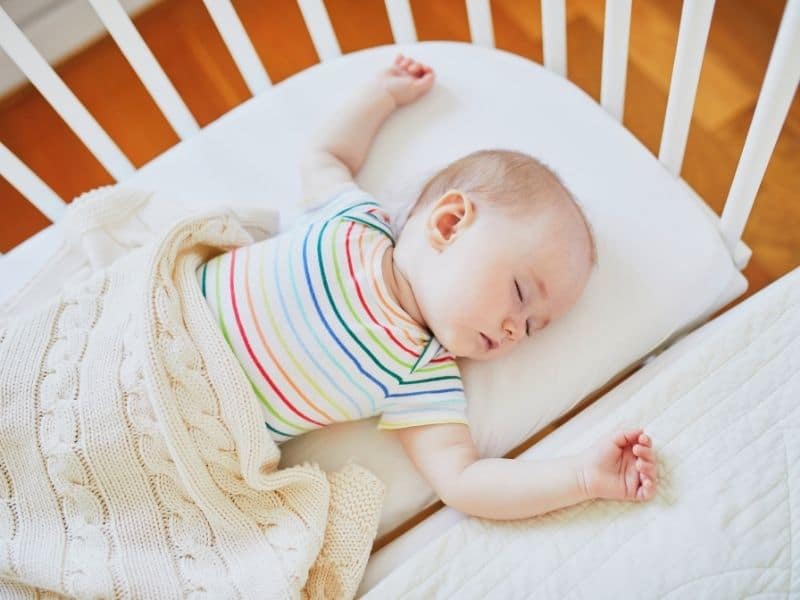If there’s one question that’s been raising dust in the parenting community without getting a clear answer, it’s the safety of bedside co-sleepers.

It’s been beaten to a pulp and broached from all angles imaginable. Yet, pickings are slim when it comes to clear, comprehensive information on the topic.
Today, I set out to right that wrong and explain everything you need to know about co-sleeping with your baby.
The basics of a bedside co-sleeper
Let’s kick things off by answering some of the basic questions.
What is a co-sleeper?
Co-sleeper is an infant bed designed to be attached to the main adult bed.
Typically, this means that the infant bed has only three sides or one side lowers.
You might also know it under one of the following names: sidecar, bed co-sleeper, or in-bed sleeper.
Is it the same thing as a bassinet?
No, it’s not. The main difference is the one “missing” side.
Most co-sleepers can be ‘turned’ into a bassinet by raising the fourth side.
Are co-sleepers safe?
There’s currently no conclusive research that would offer hard data from the AAP (American Academy of Pediatrics) about the risks and safety of a co-sleeper.
This is what they (AAP) have to say on the matter “There isn’t enough research on bedside or in-bed sleepers.”
An unpleasant surprise
If you’re anything like me, this comes as a surprise. We’re in the 21st century, and we don’t have conclusive research on co-sleepers?
All ‘surprises aside,’ I promised you some answers and answers you’ll get. At least in the form of my opinions.

My logic on the safety of in-bed sleepers
When I don’t have enough data, I rely on logic for my parenting decisions.
Before I explain how I look at things here, I have to stress that I’m not a doctor, and I’m only sharing what we did with our son.
If I were asked to put my opinion into one paragraph, I’d say this:
We know for a fact that co-sleeping (in the same bed) is not entirely safe. Over 36% of SIDS babies were found co-sleeping with an adult at the time of death.
So, co-sleeping using an in-bed sleeper can’t be completely safe either. It is, however, safer than sleeping in the same adult bed and, if you follow some safety precautions, you can lower the risks even further.
Again, by definition, you cannot eliminate the risks.
This means that a co-sleeper will never be as safe as a bassinet. A baby is only completely safe from SIDS and suffocation risks if they sleep alone and on their back for the first six months.
What I can expect to see in the research
It’s my opinion that, even when they conduct a large scale study on this, it will show common-sense results – co-sleepers are not as safe as bassinets (simply because more things can go wrong) but are nowhere near as dangerous as sharing a bed or (God forbid) sharing a sofa.
Unsafe scenarios of co-sleepers
Let’s step away from theory and into the real world, where companies sell co-sleepers and parents buy them.
Three main risks to avoid when using a bedside co-sleeper:
1 – Baby getting stuck between the two beds
This is an obvious one and probably the easiest to avoid. If the co-sleeper is not secured to the bed, a gap can form, and the baby can get stuck, injured, or worse.
What you can do
Choose a co-sleeper that attaches to your bed in a way that makes it impossible for a gap to form. Avoid basic straps and ties and go for sturdier connections that leave no more than half an inch of space in-between.
2 – Loose bedding from the adult bed
Another common sense factor. Loose bedding is a SIDS risk in bassinets and co-sleepers alike.
What you can do
If you’re co-sleeping, go with fitted sheets for the adult bed and avoid piles of bedding that move around. Go with one piece of cover that cannot move onto the co-sleeper under any circumstance.

My tactics here were always using a rigid cover rather than a flimsy blanket.
If you want to take it a step further, sew on a single button onto the sheet and open a hole on your cover. Then, securely attach the cover to the sheet before going to bed.
3 – Bed height not aligned perfectly
Both lower and higher surfaces of the co-sleeper are a risk.
If the top rail of the co-sleeper is higher than the adult bed surface, there’s a risk of the baby’s neck getting caught onto it.
On the other hand, a lower sleeping surface increases the risk of some of your bedding sliding over and down to their bed, and that’s a huge no-no.
What you can do
Get a co-sleeper that’s height-adjustable in small increments and make sure the two surfaces align perfectly.
Bottom line – you should have a clear understanding by now about where the risks are and how to minimize them. With a bit of common sense, co-sleeping becomes a viable way to stay close to your baby without putting them at risk.
Additional risk factors
There are some scenarios where co-sleeping is best avoided because the risks are too high.
I’m listing them here:
- The baby is too young – if at all possible, avoid co-sleeping for the first few months (4 to be exact)
- The baby is premature or has low birth weight and hasn’t caught up to its age group yet
- You and/or your partner are smokers (note that this has nothing to do with smoking in bed)
- The baby’s mother smoked while expecting.
- You’re taking sleep meds that put you into a deeper sleep than ‘normal.’
- You or your partner had alcohol the night before going to bed (yes, even that one glass of Cabernet Sauvignon counts)
- The surface of your bed is soft (couch, old mattress, sofa)
Final thoughts
I’m expecting a change in safety research.
Even the good people of the APP shrug their shoulders and say they cannot recommend for or against co-sleepers.
That’s strange and it’s likely to change soon.

Why?
Because parents sleep with their babies, that’s a fact.
It’s in the nature of both the parents and the infants, which will not change.
In fact, the last data I know of even suggests that co-sleeping is on the rise. In 2015, as much as 61% of babies in the US shared a bed with parents (source: U.S. Centers for Disease Control via Berkeley EDU)
In the meantime, we have to rely on our common sense and educate ourselves when making these decisions.
Paul is a passionate dad who founded Upside Dad to share his parenting journey with other new parents. He graduated from Concordia University and worked as a test engineer for over a decade. Paul loves dad jokes and craft beer.
Learn more about Paul and Upside Dad here.
